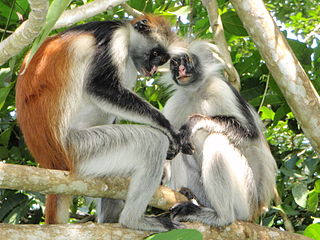The modern-day African Great Lakes state of Tanzania dates formally from 1964, when it was formed out of the union of the much larger mainland territory of Tanganyika and the coastal archipelago of Zanzibar. The former was a colony and part of German East Africa from the 1880s to 1919 when, under the League of Nations, it became a British mandate. It served as a British military outpost during World War II, providing financial help, munitions, and soldiers. In 1947, Tanganyika became a United Nations Trust Territory under British administration, a status it kept until its independence in 1961. The island of Zanzibar thrived as a trading hub, successively controlled by the Portuguese, the Sultanate of Oman, and then as a British protectorate by the end of the nineteenth century.

Zanzibar is an insular semi-autonomous region which united with Tanganyika in 1964 to form the United Republic of Tanzania. It is an archipelago in the Indian Ocean, 25–50 km (16–31 mi) off the coast of the African mainland, and consists of many small islands and two large ones: Unguja and Pemba Island. The capital is Zanzibar City, located on the island of Unguja. Its historic centre, Stone Town, is a World Heritage Site.

Pemba Island is a Tanzanian island forming part of the Zanzibar Archipelago, lying within the Swahili Coast in the Indian Ocean.

Amani Abeid Karume is a Tanzanian politician, the former president of Zanzibar. He held the office from 8 November 2000 to 3 November 2010. He is the son of Zanzibar's first president, Abeid Karume, and a member of the Chama Cha Mapinduzi (CCM) party.

Mohamed Gharib Bilal is a Tanzanian politician who was Chief Minister of Zanzibar from 1995 to 2000. He was Vice President of Tanzania from 2010 to 2015. He is a nuclear scientist by profession and also served as Permanent Secretary at the Ministry of Science, Technology and Higher Education from 1990 to 1995.
Omar Ali Juma was Chief Minister of Zanzibar from 25 January 1988 to October 1995. From 1995 to 2001, he served as Vice President of Tanzania.

The Zanzibar Revolution began on 12 January 1964 and led to the overthrow of the Sultan of Zanzibar and his mainly Arab government by the island's majority Black African population.

Zanzibar City or Mjini District, often simply referred to as Zanzibar is one of two administrative districts of Mjini Magharibi Region in Tanzania. The district covers an area of 15.4 km2 (5.9 sq mi). The district is comparable in size to the land area of Nauru. The district has a water border to the west by the Indian Ocean. The district is bordered to the east by Magharibi District. The district seat is in Stonetown. The city is the largest on the island of Zanzibar. It is located on the west coast of Unguja, the main island of the Zanzibar Archipelago, north of the much larger city of Dar es Salaam across the Zanzibar Channel. The city also serves as the capital of the Zanzibar Urban/West Region. In 2022 its population was 219,007.

The Zanzibar Archipelago are a group of islands off the coast of mainland Tanzania in the sea of Zanj. The archipelago is also known as the Spice Islands. There are four main islands, three primary islands with permanent human populations, a fourth coral island that serves as an essential breeding ground for seabirds, plus a number of smaller islets that surround them and an isolated tiny islet.

Chake-Chake is a town located on the Tanzanian island of Pemba and capital of Chake Chake District. It is in the centre of a deep indentation in the west coast called Chake-Chake Bay. Chake-Chake is historically the capital of Pemba Island, and the seat of Pemba's court. Pemba's only airport is 7 km south-east of Chake-Chake. The Mkama Ndume ruins are close to the airport in Pujini village.
People have lived in Zanzibar for 20,000 years. The earliest written accounts of Zanzibar began when the islands became a base for traders voyaging between the African Great Lakes, the Somali Peninsula, the Arabian peninsula, Iran, and the Indian subcontinent. Unguja offered a protected and defensible harbour, so although the archipelago had few products of value, Omanis and Yemenis settled in what became Zanzibar City as a convenient point from which to trade with towns on the Swahili Coast. They established garrisons on the islands and built the first mosques in the African Great Lakes Region.
Ras Mkumbuu is a long narrow peninsula on the central west coast of Pemba Island, one of the two main islands of Tanzania's Zanzibar Archipelago. The town of Chake-Chake, one of the island's main population centres, is located immediately to the south of it on Chake-Chake Bay. The peninsula stretches due west for 12 kilometres, tapering to only a few tens of metres wide at its narrowest point. The peninsula, along with Fundo Island to the north, forms part of a natural breakwater which provides a calm harbour for the northern town of Wete.

Pemba Airport is an airport in the Zanzibar Archipelago located on Pemba Island. It is also known as Karume Airport and Wawi Airport. It is located approximately 7 kilometres (4.3 mi) southeast of Chake-Chake, the capital of the island. The Zanzibar government is looking into the possibility of renaming the airport to Thabit Kombo Jecha in recognition of his role in the Zanzibar Revolution.

The People's Republic of Zanzibar was a short-lived African state founded in 1964, consisting of the islands of the Zanzibar Archipelago. It existed for less than a year before it merged with Tanganyika to create the United Republic of Tanganyika and Zanzibar, which would be renamed to Tanzania in October of that year.

This is a survey of the postage stamps and postal history of Zanzibar.

The wildlife of Zanzibar consists of terrestrial and marine flora and fauna in the archipelago of Zanzibar, an autonomous region of Tanzania. Its floral vegetation is categorized among the coastal forests of eastern Africa as the Southern Zanzibar-Inhambane coastal forest mosaic and the Northern Zanzibar-Inhambane coastal forest mosaic. Its faunal species are mostly small animals, birds, and butterflies.
The Kidike Root Site is a nature area in the central part of Pemba Island. It has the endangered Pemba Flying Fox, considered the largest number bat species in the world. Other animals in the island are the vervet monkeys, Mozambique cobras, tortoises, bush crabs, red eyed doves and mangrove king fishers.
Rashid Seif Suleiman, is a member of the Zanzibar House of Representatives and minister of communication and infrastructure in the Revolutionary Government of Zanzibar Tanzania.

Lumumba Secondary School is a public, coeducational secondary school in Saateni, Zanzibar, Tanzania. It is Zanzibar's largest secondary school, and has been called one of the best secondary schools in Zanzibar. From 1958 until the Zanzibar Revolution of 1964, the school was named in honor of King George VI.












